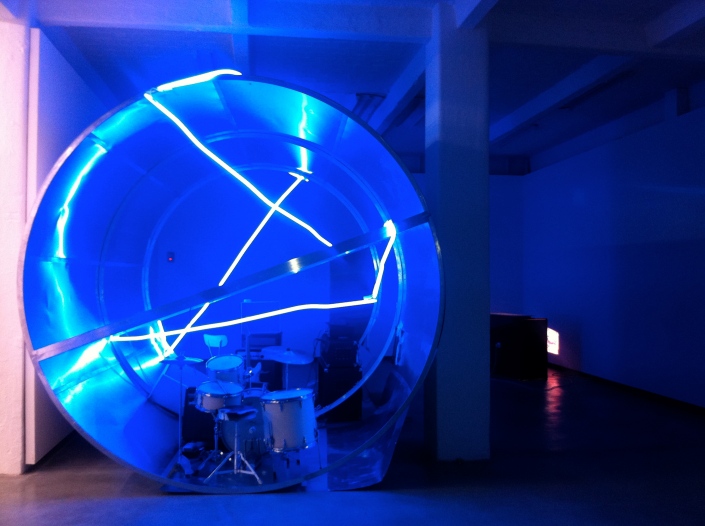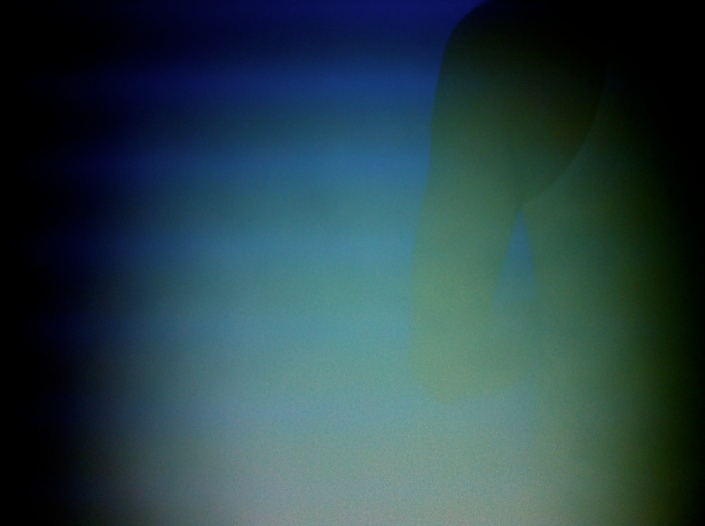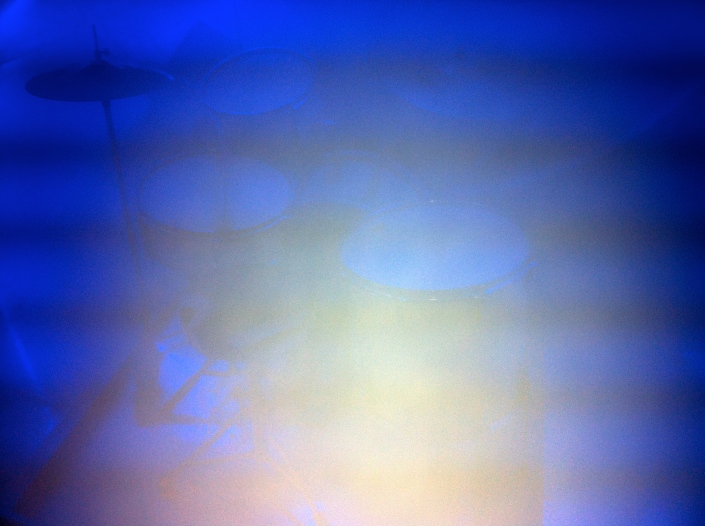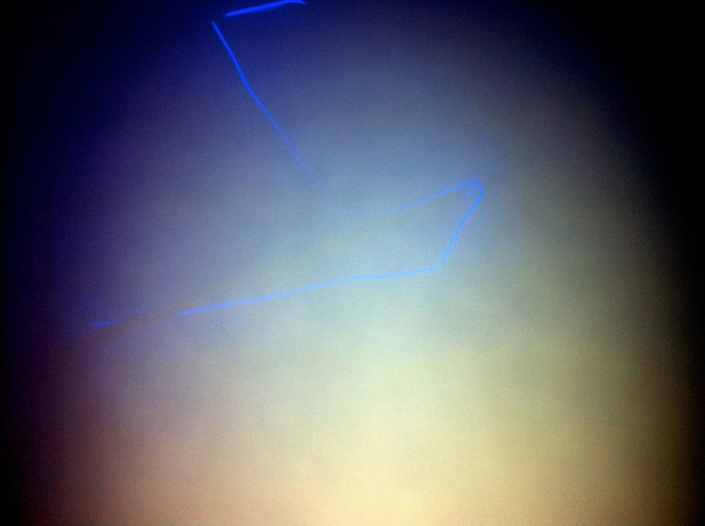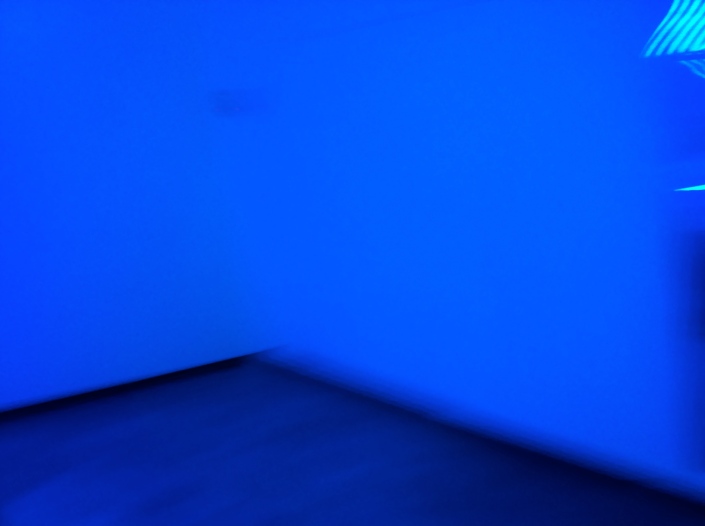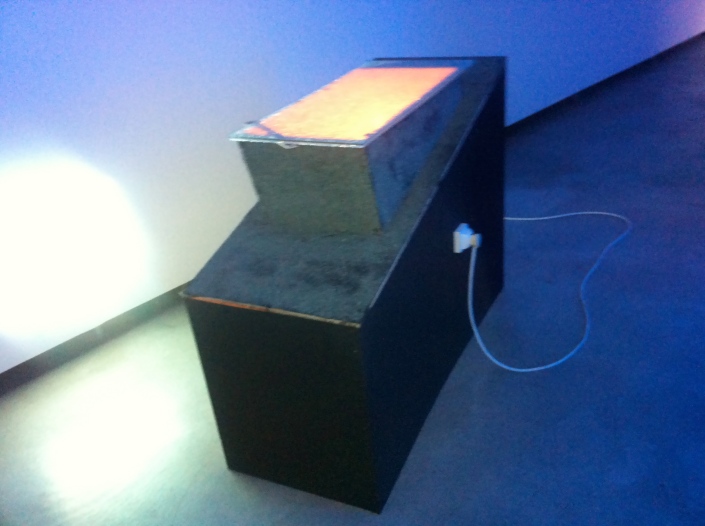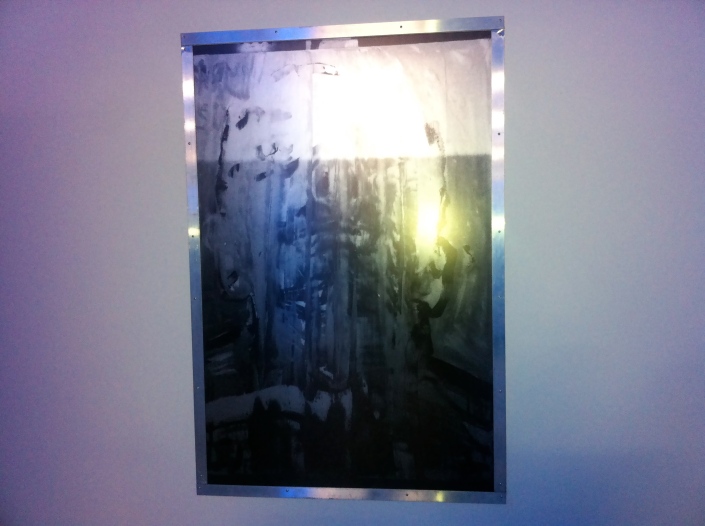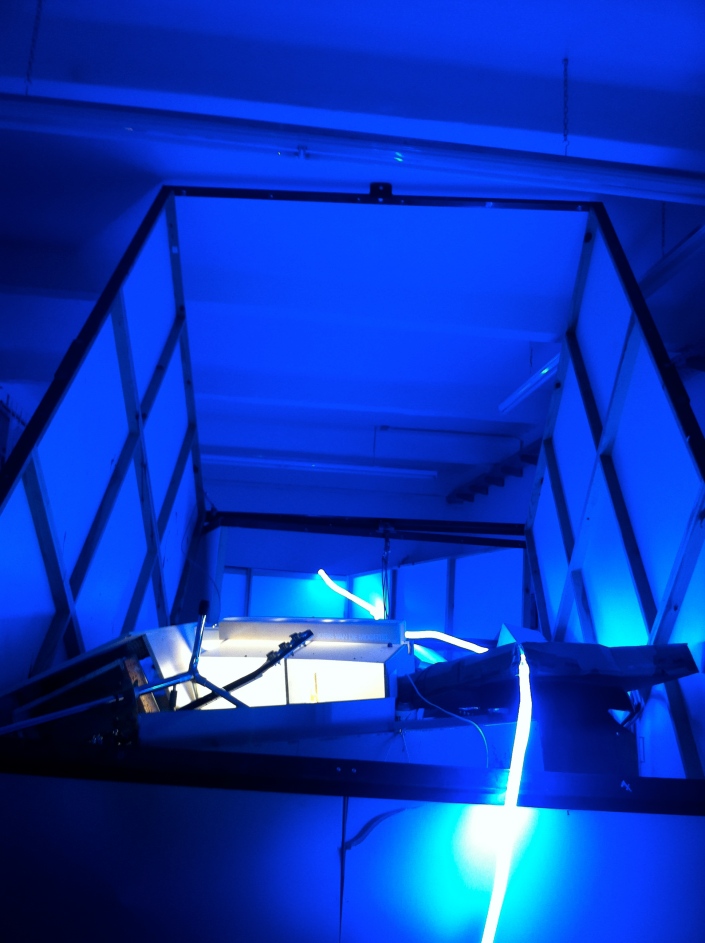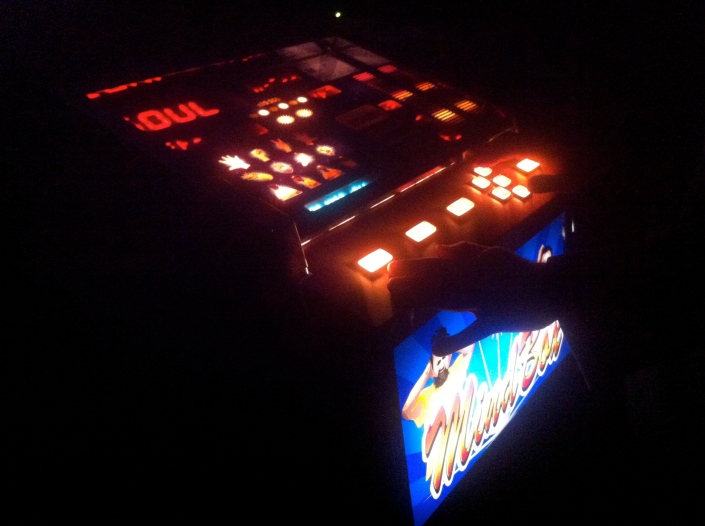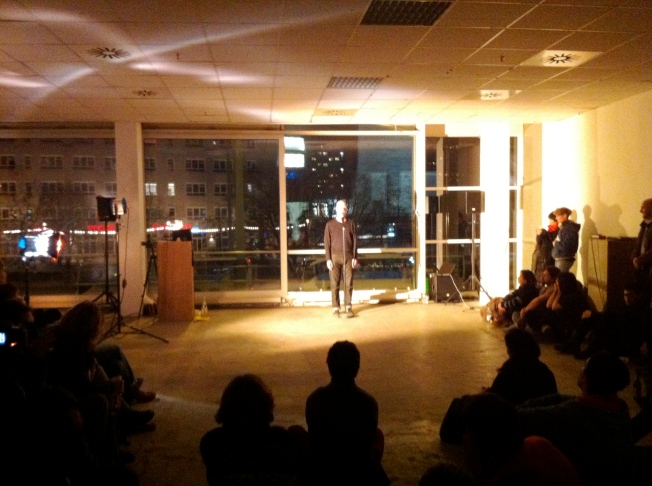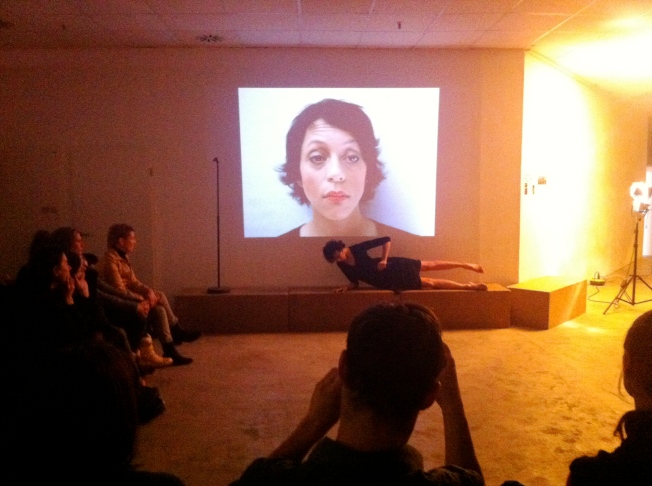Murcof and AntiVJ‘s Simon Geilfus @ Berlin Atonal
Yesterday we experience one of the most immersive experience with the collaboration between Mexican electronic composer Murcof and AntiVJ‘s Simon Geilfus at Berlin Atonal. With large, semi-transparent screens, they create a fully immersive environment in which microscopic particles, geometric grids and organic elements are mapped in wondrous 3D perspective to the sound of ambient and droning electronica. As amateurs pics I took with my iphone will not make justice to the show, I have collected some professional pics from this collaboration that already last 4 years (2009).
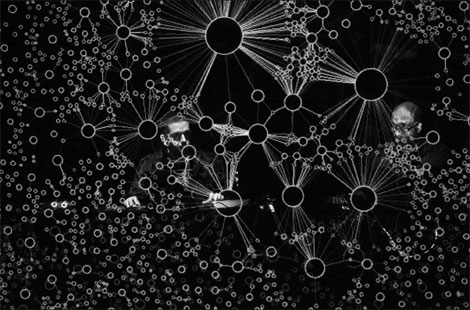
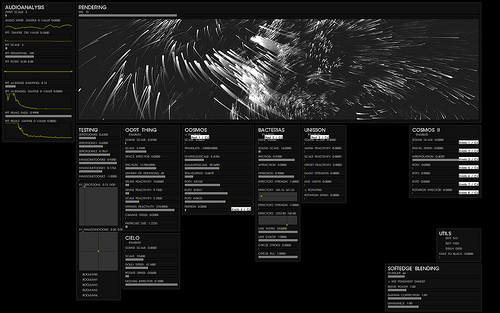
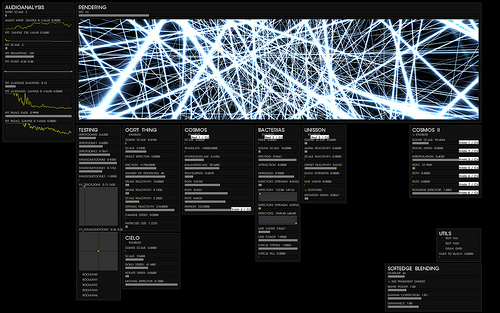
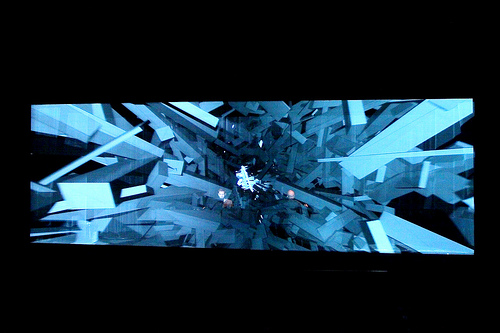
‘Public face’ by J. von Bismarck, B. Maus & R. Wilhelmer @ Berlin Public Space, March 25th, 2013
It is about a year -started on the 2nd of June, 2012 and it will finish the 31st of May 2013- that the artist Julius von Bismarck, the experimental designer Benjamin Maus and the filmmaker Richard Wilhelmer made the installation “Public Face,” an oversized smiley face made of steel and neon tubes on the roof of the silo on the Malzfabrik grounds. The second public art project by District Arts and Cultural Promotion scans various facial expressions of pedestrians, who are filmed in the Tempelhof area by a camera and will be inaugurated during the Malzwiese, the annual summer event of the Malzfabrik. The film material is analysed within a few seconds with the aid of software (developed by the Fraunhofer Institut). In regular intervals, the emotions of the filmed and thus surveiled persons are transferred to the smiley, which then takes on a corresponding facial expression.
Von Bismarck, Maus and Wilhelmer thus convey a critical comment on surveillance technologies and social control mechanisms. “Public Face” reflects the dynamics of social coexistence, which are becoming more and more relevant within the context of sustainability and new information technologies.
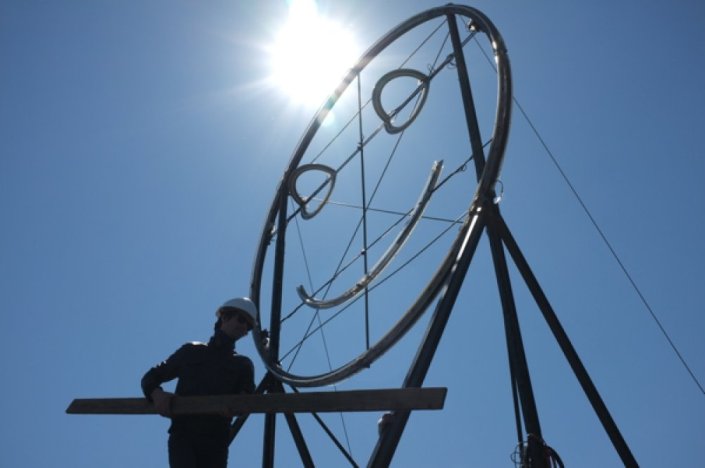
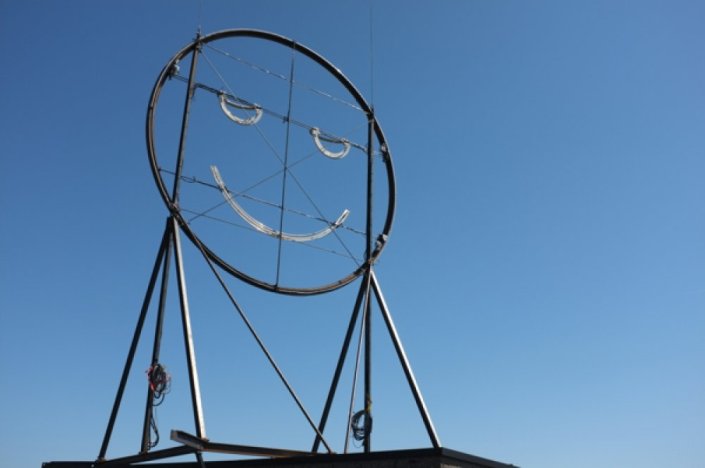
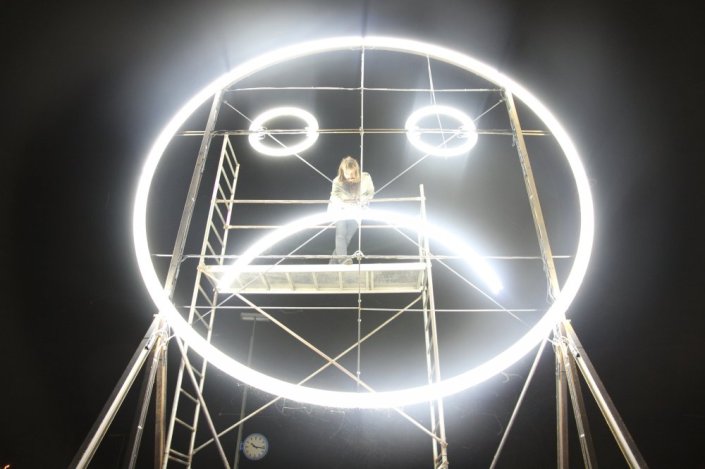
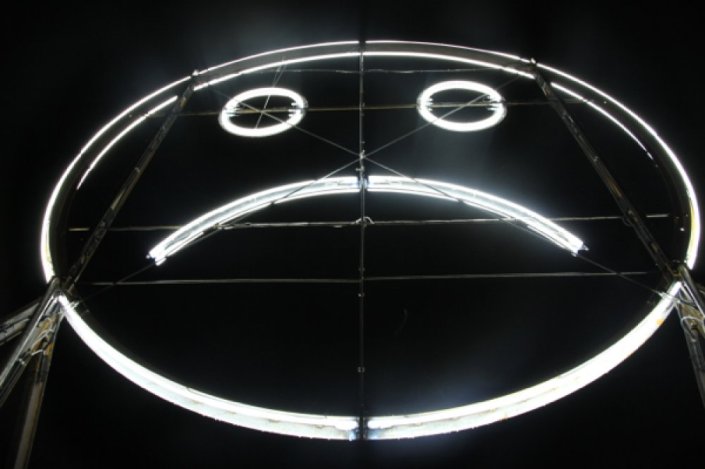
The first project Public Face I (Stimmungsgasometer) was presented in Berlin in 2008 and it was the same smiley on a huge screen from which one can read the average mood of the Berlin citizens. Also used the same software to obtain mood data from public which was also stored on a server and processed by the smiley on the screen to visualise the emotions in real-time.
Text source:
http://www.district-berlin.com/detail_full.php?categorie_id=19&lang=en&article_id=74
http://www.juliusvonbismarck.com/bank/index.php?/projects/stimmungsgasometer/
‘Schwarz oder weiß, es ist mir gleich. Es gibt keine Farben in diesem blauen Reich’ Joris Van de Moortel @ Künstlerhaus Bethanien, January 17th, 2013
Joris Van de Moortel is concerned with architecture as an important medium of our mental and physical experiences of space. Besides musical performances, he creates assemblages, which often resemble stage sets or the remains of a performance. For his generally large-scale installation works, Van de Moortel uses pedestals, walls and boxes or a number of things that seem to have been found by chance: towels, musical instruments, door leaves, a single window, or an old cooking pot are combined into unpretentious artefacts, which seem to bear their own, expansive dynamics within them. The artist bundles, ties, screws, and then shuts up his work in wooden or acrylic glass cases, or he has them hang from the ceiling in bin-bags. His environments – often in conjunction with musical performances – are inspired by found situations and often they have no clearly defined beginning, middle or end. Thus, the artist often ‘recycles’ the work at the end of an exhibition by destroying it, and constructing a new work with the help of the resultant junk. In this way, the “undoing” in Van de Moortel’s work becomes an important aspect of the “doing”.
Joris Van de Moortel is a grantee of the Flemish Government in Künstlerhaus Bethanien. As the 17th of January were also Open Studios at Bethanien, this last picture is an installation in his studio.
The video below correspond to the last 25 seconds of the performance that accompanied the exhibition-installation… all is blue…
EXHIBITION: 18.01. – 10.02.2013. Tue – Sun: 2 – 7pm. Admission free.
Text source: http://www.bethanien.de/en/exhibitions/automatisch-gespeicherter-entwurf-2/
2012 in review
The WordPress.com stats helper monkeys prepared a 2012 annual report for this blog.
Here’s an excerpt:
600 people reached the top of Mt. Everest in 2012. This blog got about 5,700 views in 2012. If every person who reached the top of Mt. Everest viewed this blog, it would have taken 10 years to get that many views.
BodyControlled #5 @ LEAP, December 7th, 2012
INSTALLATIONS
MindBox – Christian Graupner (DE)
With the audio-visual triptych MindBox Christian Graupner & partners created an audience reactive installation and an electro acoustic music instrument using the body of a ‘one armed bandit’ as an user interface. MindBox is a part of the work cycle H.RP [Humatic Re-Performing].
The installation attracts visitors’ senses offering a joyful gambling- game around musical, choreographical and cinematographical elements as dance & beat-boxing. The latter expression describes a form of vocal percussion from which the installation derives its title. MindBox is a triple-channel ‘media catapult’ to be touched. The arm and buttons of the modified fruit machine function as a tactile interface to the actions of a filmed character whose vocal- & movement clusters can be re-composed and re-performed by the audience.
MindBox is an artistic collaboration between: Christian Graupner (GER) – Humatic, inventor, media artist, director, composer; Roberto Zappalà (IT) – performer, choreographer; Norbert Schnell (FR) – IRCAM Centre Pompidou, interactive music & sound design; Nils Peters (DE) – Humatic, system developer and software artist.
FeeedBack 5 *public prototype & casting module – Christian Graupner (DE) & Alan Gleeson (IE)
FB5pp demonstrates the evolving audio features of the pipelined multi-screen media installation FeeedBack 5.
One by one, female visitors are invited to put on headphones and to wear a “prepared” electric guitar. In doing this they accept to play the main role in an intense re-performance, by becoming a experienced feedback guitar player and creating their own rich soundscape .
A smartphone and additional sensors are mounted on the guitar to transmit accurate 3D motion and position data to an external system which provides a reactive real-time soundtrack giving direct response to players activity and creating a close-to-real simulation. Surrounding visitors can observe the player becoming one with the instrument in swaying movements but are not able to listen to the spectacular soundtrack.
In addition to being a standalone sound installation FB5pp fires the imagination for the pipelined multi-channel / multi-user audiovisual work FeeedBack 5 (http://fb5.humatic.net). The setup serves for casting and test shootings that will develop to the complex piece which will be realized in early 2013.
Concept and Realisation: Christian Graupner (Humatic) & Alan Gleeson. Guitar Feedback Footage: Blacky Schwarz-Ruszczynski, Project Partner: Dr. Prof. Werner Jauk, Universität Graz, Android: Control Software: Nils Peters ( Humatic). Additional Technical Support: Servando Barreiro & Jo Frgmt Gyrs
PERFORMANCES
Zunge lösen | Releasing the tongue – Christian Kesten (DE)
zunge lösen by Christian Kesten consists of the following elements: (fine) slaps of the tongue on the bottom of the mouth, (visible) tongue movements and tongue movements, which articulate a (chance) text, based on a given material of phones (syllables and smaller). Through breath and larynx they are made audible from time to time. Tongue movements, breath and voice function as independent layers which interact.
G is for Guam Flying Fox (Pteropus tokudae) – Christian Kesten (DE)
Über die Lebensweise des Guam-Flughunds ist nichts bekannt. [Nothing is known about the Guam Flying Fox’s way of living.] for voice, hands/arms, feet.
The piece was originally composed for Antonia Baehr and her Abecedarium Bestiarium.
Lips revisited – Carlos Sandoval (MX) and Etoile Chaville (FR)
Lips revisited is a study on gesture’s contrast and interpretation. The first version of the piece (an approach on microgestures) was premiered at LEAP with Almut Kühne one year ago. This time the piece is much more fragmented both in terms of its elaboration and its discourse. With Carlos Sandoval: Live electronics and actions and Etoile Chaville: Voice and dance
Go Karamazov – Eva Sjuve (SE)
Go Karamazov is an interface for live interactive performance, a wearable controller with sensors as inputs, reacting to movements of the performing body. The live audio is programmed in Pure Data and is addressing issues of electromagnetic propagation. Light has been integrated into the design adding a visual element of light and shadows. The sonic output from the controller is composed in relation to the movements of the performer.
Eva Sjuve has been developing interfaces for gestural use since the late 1990s. GO interface is an early wireless interface, developed in 2006 for the performing arts, as a Nordscen Artist in Residency. GO Karamazov was later commissioned by New Composers Series in New York, and premiered at PERFORMA 07 biennale in New York City, as one of the highlights. Go Karamozov is an interface that adresses issues of electromagnetic propagation, via a very free adaptation of Dostoyevsky’s novel the Brothers Karamazov.
“Robert Walser: Der Spaziergang” (group show) @ Zink Galerie, November 23rd, 2012
Robert Walser‘s novel “Der Spaziergang (The Walk)” has inspired Galerie Zink for the homonymous exhibition “Robert Walser – Der Spaziergang”, in which the next artists Euan Macdonald, Marcel van Eeden, Jana Gunstheimer and Natalie Czech participate to approximate to the person of Robert Walser and his work.
Euan Macdonald presents a bundle of 85 pencil drawings, which have been developed over a period of three years at different locations. The drawings are complemented with 22 antiquarian postcards. In his drawings, Macdonald uses the various manifestations of landscape and questions the familiarity of this phenomenon. Connecting the drawings to the postcards -from the period 1911 to 1913, period referenced in Walser’s writings and starting point of his retirement in Switzerland (1913)-, serve as historical reference. The interplay between familiarity and unfamiliarity an indeterminacy of the visual world can perfectly illustrate Robert Walser’s novel.
Marcel van Eeden used in his great drawing “Celia” (2006) long passages from Robert Walser’s “Der Spaziergang”. In Zink’s exhibition he shows the series “Herisau – Wil, 23.April 1939”, 2012. The work is inspired in a walk of 28 kilometers taken from Herisau to Wil by Robert Walser’s admirer and later guardian, Carl Seelig on 23rd April, 1939 materialized in his writing “Walking with Robert Walser”. Van Eeden uses text fragments from Carl Seelig’s report in the installation presented here. As it is usual in his work, the artists refers to events before his own birth in 1965.
Jana Gunstheimer approaches the person of Robert Walser in a sort of indirect portrait. For many visual artists, the writer, who lived between euphoria and despair, has became a fascinating person. He withdrawn himself in the protection of asylum in Waldau near Bern in 1929. In the last years of his life, Robert Walser lived fully retracted and no longer wrote. This state of isolation is what Jana Gunstheimer transfers to drawings with an atmospherically charged interior similar to a burnt house.
The work “Adieu ihr schönen Worte”, 2010, by Natalie Czech refers to a quote by Ingeborg Bachmann, but it has special validity in terms of the biography of Robert Walser: „Adieu, ihr schönen Worte, mit Euren Verheißungen. Warum habt Ihr mich verlassen, war Euch nicht wohl?“
Very free translation from me, original text in German. Text source: http://www.galeriezink.de/fileadmin/zink/press_releases/Pressetext_Robert_Walser_Der_Spaziergang.pdf
DesertMed @ NGBK, October 26th, 2012
Desertmed is an interdisciplinary research project. The “blind spots” on the European map serve as its subject matter: approximately 300 uninhabited islands in the Mediterranean Sea. A group of artists, architects, writers and theoreticians travelled to about 40 of the —often difficult to access— islands in search of clues, impartially cataloguing information that can be interpreted in multiple ways. The result is a pool of photographs, audio and video recordings, presented along with further artistic contributions. They examine the myriad ways in which the individual islands are used and – accordingly – their significant political, economic, and historical interrelationships.
Artists: Fabian Bechtle, Bik van der Pol, Leon Kahane, Deborah Ligorio, Stefanos Tsivopoulos, Luca Vitone and the Desertmed Collective: Giulia Di Lenarda, Giuseppe Ielasi, Armin Linke, Amedeo Martegani, Renato Rinaldi, Giovanna Silva with contributions by:Elina Axioti, Giulia Bruno, Daniele Ansidei, Aristide Antonas, Antonia Dika, Laura Fiorio, Stefano Graziani, Franck Leibovici, Donato Ricci
Project Group: Fabian Bechtle, Wilfried Kuehn, Armin Linke, Marina Sorbello, Antje Weitzel
Text source: http://ngbk.de/development/index.php?option=com_content&view=article&id=256:desertmed&catid=11&Itemid=340&lang=en
Open Studios @ Künstlerhaus Bethanien, August 16th, 2012
On Thursday August 16th we were able to see Künstlerhaus Bethanien artists studios. The atmosphere in the studios was like a international artists dorm as they become scholars from different countries. Strolling through customized workshops, it was offered the exciting opportunity to see the artwork on the scene and deal directly with the artist.
Among this year’s artists, which are funded through the International Studio Program, include:
Mats Adelman (Guest Artist), Viktoria Binschtok, Mauro Cerqueira, Hadassah Emmerich, Jan Freuchen (Guest Artist), Roey Heifertz, Sharon Houkema, Hyein Lee, Michael Lee, Joris van de Moortel, Daniel Palacios, Linn Petersen, Judy Radul (DAAD ), Constantinos Taliotis, Aiko Tezuka, Mark Themann, Jane Ritchi, Rebecca Wilton, Daniel Young and Marie Zolamian.
‘The Box’, Paul McCarthy @ Neue Nationalgalerie, August 25th, 2012
McCarthy life’s work, which he has been creating since the 1960’s, was inspired by “primal themes” in American society and is characterized by irony, unmasking and the grotesque, as well as a complex nexus of interaction between media and materials. He makes use of Disneyland, comics, Hollywood and set pieces from art history. In his content-packed performances – which strain the limits of endurance – conceptual art, action painting, surrealism and minimalism seem to shift space. McCarthy introduces moments of the uncanny, of dislocation in space or masquerade, a situation that is reflected in the almost stage-like, three-dimensional collage “The Box” (1999): an oversized wooden box, into which McCarthy has built his entire studio, i.e. the setting for his creativity and the production of his artworks. The installation appears outwardly to be an inconspicuously simple trunk, yet inside a stunning variety of things that reference not only McCarthy himself, but his extensive creations from the beginning of his career to the present as well. The box with over 3,000 fixed objects from his studio – tables, equipment, tools or boxes – is tilted 90 degrees. Due to the rotation, it becomes an almost surreal spatial experience. This ties into McCarthy’s radical performance art and opens up new perspectives on the creative space.
As the single work exhibited in the expansive hall, “The Box” is granted particular significance. The narrowness of the studio – the private space – meets the expansiveness of the surrounding – the public space. At the same time, this artwork relates to the collection housed in the Neue Nationalgalerie, which is exhibited in the basement. Specific points of connection can be found to the cultural assemblage from the 1960’s exhibited here (Daniel Spoerris “Snare-picture”) or Bruce Nauman‘s early studio videos (“Bouncing in the Corner”). The view into the studio, a constantly recurring theme by modern artists, is in this version by Paul McCarthy the portrait of an unsparing artist who is willing to reveal everything.
Text source: http://www.smb.museum/smb/kalender/details.php?objID=32753
